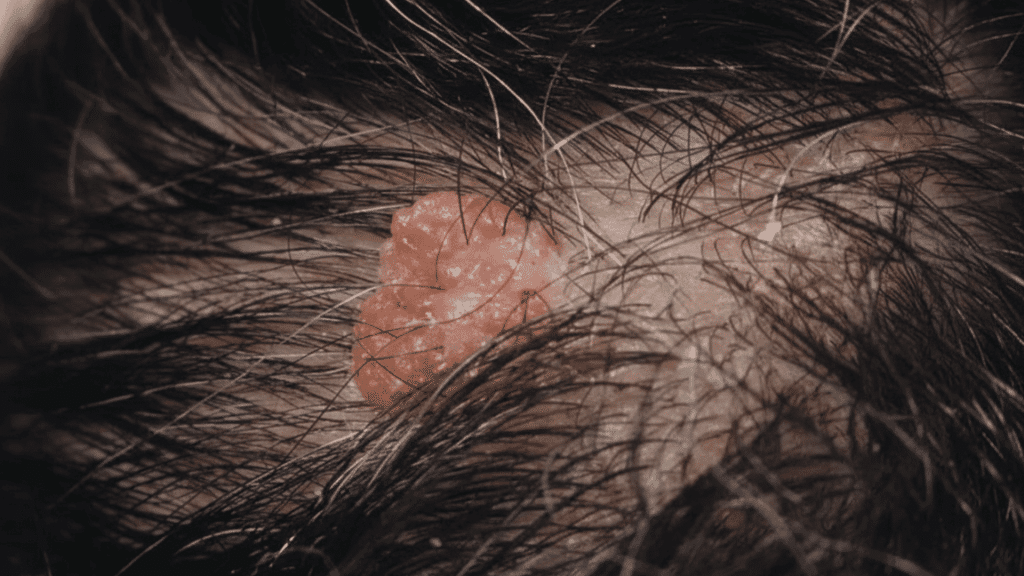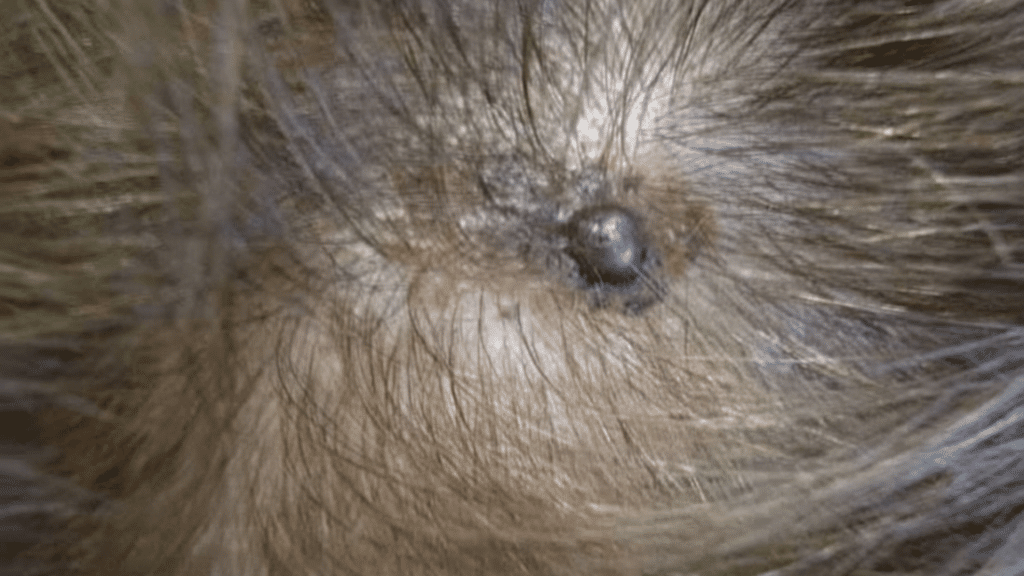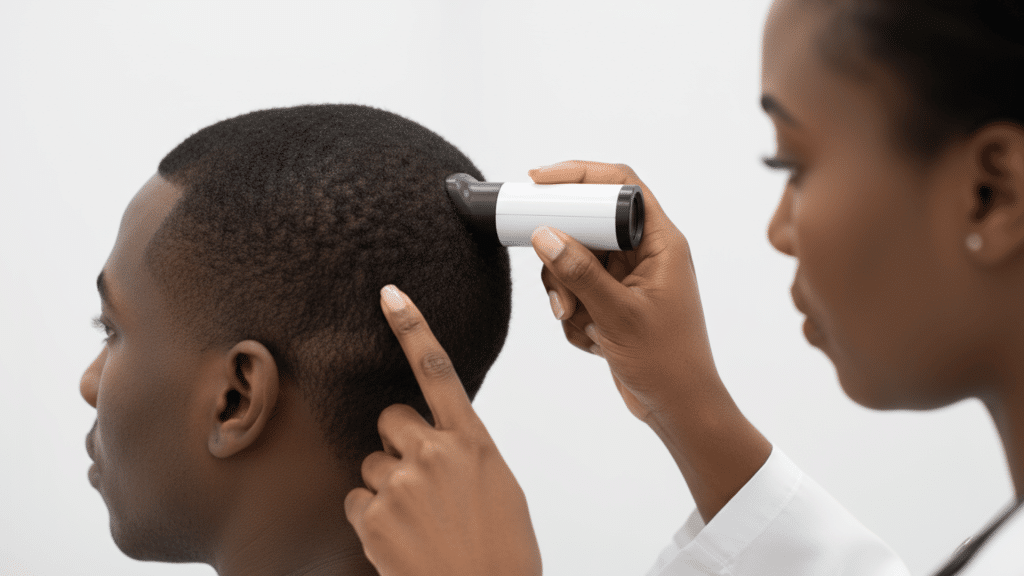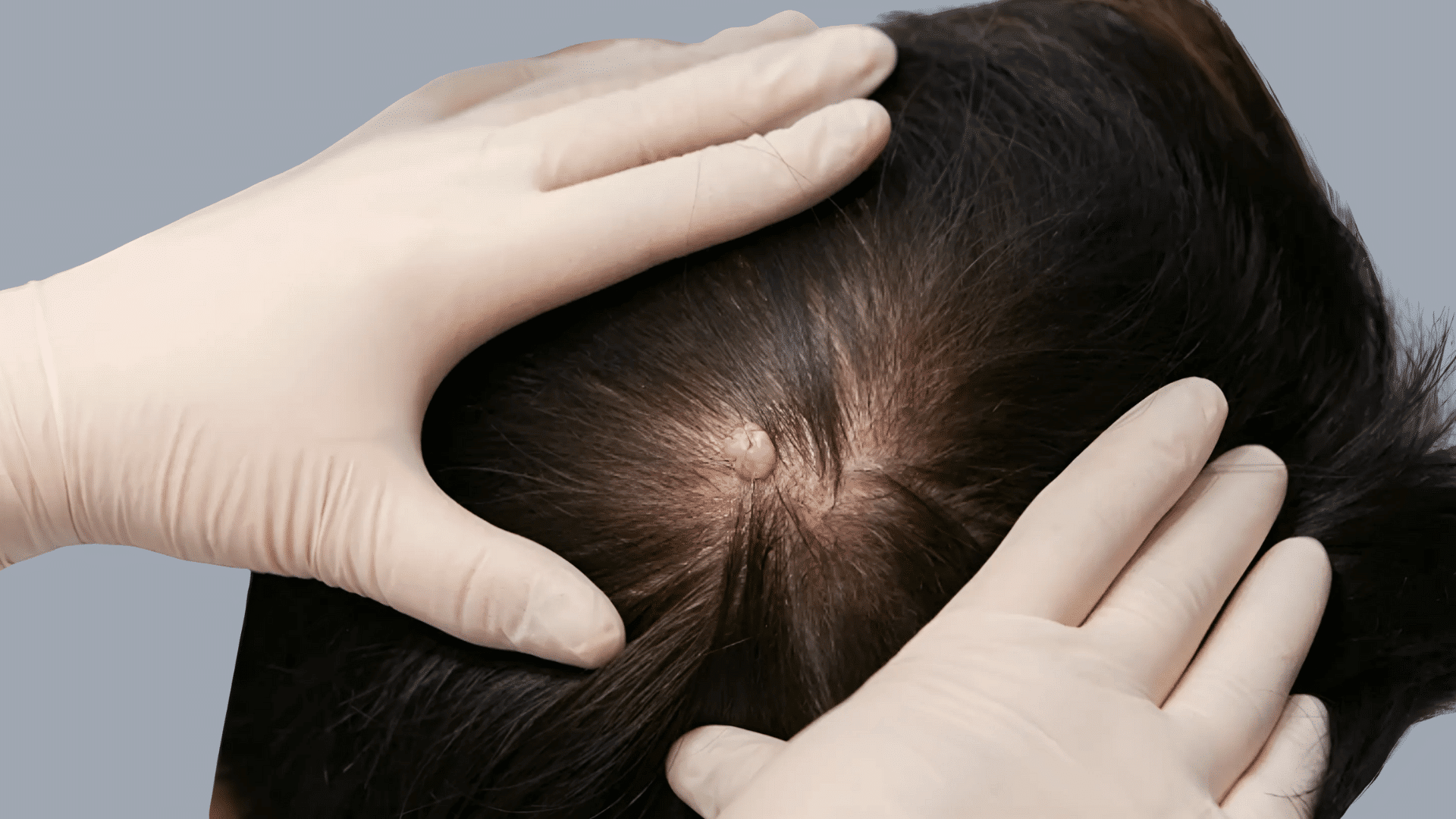Many people find small, dark spots on their scalp during routine hair washing or styling.
Moles on the scalp are actually quite common, appearing anywhere from the crown to the back of the ears. While most scalp moles are harmless, they can sometimes cause concern due to their location and appearance.
This blog offers clear, practical guidance on moles on the top of the head and other scalp locations.
Readers will learn when to monitor these spots, how to differentiate between normal and concerning features, and when professional evaluation becomes necessary.
Disclaimer: Some images in this blog may be graphic or disturbing. They are for educational purposes only and not for self-diagnosis or treatment. Please consult a healthcare professional for any symptoms. Viewer discretion is advised.
Appearance of a Mole on the Scalp
Scalp moles typically appear as small, round or oval spots ranging from light brown to nearly black.
Most measure between 2 and 6mm in diameter, roughly the size of a pencil eraser or smaller. These growths usually have smooth, even borders and uniform coloring throughout.
Common characteristics include:
- Flat or slightly raised surface texture
- Consistent brown, tan, or dark pigmentation
- Well-defined edges without irregular spreading
- Hair may grow directly through the center
Some individuals notice pink moles on the scalp, which appear lighter due to reduced melanin production.
These pale variants maintain the same rounded shape and smooth texture as darker moles, but with a lower pigment concentration.
Signs a Mole on the Scalp Could Be a Problem

When considering a mole on the scalp, it’s wise to be aware of what might make it a cause for concern. While most moles are harmless, noticing certain changes can be a good reason to speak with a healthcare professional.
- Noticeable changes in size, shape, or upgrading of a mole.
- Irregular, blurred, or jagged edges differing from smooth, well-defined borders.
- Presence of multiple colors or uneven pigmentation within the mole.
- Development of symptoms such as bleeding, itching, or crusting.
- A mole that appears different from other moles on the scalp.
- Emergence of new moles after age 30, especially if exhibiting any concerning features.
- Any persistent, unusual spot or growth that doesn’t heal or change over time.
Keeping these signs in mind can help one stay proactive about their health. If any of these changes are noticed, it’s always best to consult a doctor to ensure peace of mind.
Melanoma on the Scalp

Melanoma represents a serious form of skin cancer that becomes particularly dangerous when it develops on the scalp.
This location proves especially concerning because hair often conceals suspicious moles, leading to delayed diagnosis and potentially worse outcomes. Understanding the warning signs is crucial for early detection and intervention.
The ABCDE method helps identify problematic moles: Asymmetry means one half doesn’t match the other while irregular Borders appear jagged or poorly defined.
Color Variation involves multiple shades of brown, tan, black, or unusual colors, such as red, white, or blue, within a single mole.
The diameter typically exceeds 6 millimeters, although smaller melanomas can also occur. Most importantly evolving characteristics, any changes in size, shape, color, or texture over time, demand immediate attention.
Regular scalp examinations whether performed by the individual themselves or by a healthcare provider enable early detection.
Since melanoma caught early has excellent treatment outcomes, staying vigilant about these warning signs can literally be life-saving for individuals at risk.
Treatment Options for Melanoma
When doctors diagnose melanoma on the scalp, several proven treatment methods become available. The specific approach depends on factors such as tumor thickness, location, and whether the cancer has spread.
Surgical Excision
Surgeons remove the melanoma along with surrounding healthy tissue to ensure complete elimination. This standard treatment is most effective for localized tumors.
The procedure typically requires local anesthesia, and patients can return home the same day. Recovery involves keeping the area clean and monitoring for proper healing over several weeks.
Mohs Surgery
This specialized technique removes cancer layer by layer while examining tissue under a microscope.
Mohs surgery offers the highest cure rates for scalp melanomas in sensitive areas. The process continues until clear margins appear, preserving the maximum amount of healthy skin.
Most patients experience minimal scarring compared to traditional excision methods.
Radiation Therapy
High-energy beams target cancer cells when surgery isn’t suitable for elderly patients or complex locations.
Radiation therapy delivers precise doses over multiple sessions spanning several weeks. Side effects may include temporary skin irritation and fatigue.
This option is particularly well-suited for patients who are unable to undergo surgical procedures.
Immunotherapy Treatment
Modern immunotherapy enables the body’s immune system to recognize and effectively attack melanoma cells. These treatments include checkpoint inhibitors and targeted therapy drugs.
Advanced melanomas often respond well to immunotherapy combinations. Patients typically receive treatment through IV infusions at specialized cancer centers.
Professional oncologists work closely with patients to determine the most appropriate treatment plan.
Early consultation with specialists ensures access to the latest therapeutic options and improved long-term outcomes for scalp melanoma cases.
Key Facts About Pink Moles on the Scalp
Pink moles on the scalp are characterized by their light, pinkish color due to reduced melanin. Unlike typical darker moles, their subtle appearance can make changes harder to notice.
Although many pink moles are harmless, they may be more sensitive to sun exposure, increasing the need for protection.
It’s essential to monitor any changes in size, shape, or texture. Any signs of irritation or irregularity warrant professional evaluation.
Protecting the scalp with hats or sunscreen and performing regular checks helps maintain scalp health. Prompt consultation with a dermatologist ensures early detection of any potential issues.
Tips for Scalp Mole Care and Prevention
When it comes to caring for and preventing issues with a mole on the scalp, proactive habits are key.
By being mindful and regular with their checks, individuals can spot potential problems early on. It’s about being vigilant without being worried.
- Regular Self-Checks: Individuals should inspect their scalp regularly, either with a hand mirror or with the assistance of a family member, to look for any changes in existing spots.
- Sun Protection is Vital: Applying sunscreen directly to the scalp or wearing a hat can help shield a mole on top of the head from harmful UV rays.
- Be Mindful of Color: This is particularly important for lighter-colored pink moles on the scalp, which may be more susceptible to sun damage.
- Early Detection is Best: Noticing changes in a timely manner allows for a quicker consultation with a professional, leading to the best possible outcome.
Ultimately, a combination of regular self-checks and proper sun protection is the best defense. Taking these simple steps can make a big difference in maintaining one’s scalp health.
When to See a Doctor

It is recommended that a person consult a healthcare professional if they observe any concerning changes on their scalp. This includes any spot that changes in size, shape, or color.
If a growth begins to bleed, itch, or become painful, it is a clear sign to seek an expert’s opinion.
Even if a spot appears benign, any new or existing growth that looks different from others should be examined by a dermatologist.
Individuals with a personal or family history of skin cancer should consider getting regular, professional skin examinations, as early detection is crucial for the best health outcomes.
Conclusion
Ultimately, understanding and managing any mole on the scalp comes down to proactive care and vigilance. While many scalp moles are benign, their hidden location makes regular self-examination a critical habit.
By recognizing the signs to watch for, such as changes in size, shape, color, or the appearance of a new mole, you’re empowered to take control of your health.
The key is staying attentive without becoming anxious. An informed approach helps identify issues early, making early detection most effective. defense against serious skin conditions.
Your scalp health deserves the same attention you give the rest of your skin.







